Planar Inverse Statics and Path Planning for a Tendon-Driven Discrete Continuum Robot
Abstract
1. Introduction
2. Materials and Methods
2.1. Developed Unit
2.2. Unit Bending Procedure Under and
2.3. Experimentally Constructed Inverse Statics of One, Two, and Three Serially Connected Units
2.3.1. Inverse Statics of One, Two, and Three Serially Connected Units in the Bending Direction
2.3.2. vs. Characteristics of One, Two, and Three Serially Connected Units in the Releasing Direction
3. Results and Discussions
3.1. Inverse Statics Validation Test Results
3.2. Ansys Dynamic Analysis Results for Unit Bending
3.3. Inverse Statics-Based Planar Path Planning for Three Serially Connected Units
- , →, ,
- , () →() →,
- , () →() →,
- , () →() →,
- , →, →
- , →, →
- , →, →
| Algorithm 1: Planar path planning for three serially connected units |
 |
4. Conclusions
Author Contributions
Funding
Data Availability Statement
Conflicts of Interest
References
- Burgner-Kahrs, J.; Rucker, D.C.; Choset, H. Continuum Robots for Medical Applications: A Survey. IEEE Trans. Robot. 2015, 31, 1261–1280. [Google Scholar] [CrossRef]
- Wang, M.; Dong, X.; Ba, W.; Mohammad, A.; Axinte, D.; Norton, A. Design, modelling and validation of a novel extra slender continuum robot for in-situ inspection and repair in aeroengine. Robot. -Comput. -Integr. Manuf. 2021, 67, 102054. [Google Scholar] [CrossRef]
- Yang, Z.; Yang, L.; Sun, Y.; Chen, X. Comprehensive kinetostatic modeling and morphology characterization of cable-driven continuum robots for in-situ aero-engine maintenance. Front. Mech. Eng. 2023, 18, 40. [Google Scholar] [CrossRef]
- Li, G.; Yu, J.; Dong, D.; Pan, J.; Wu, H.; Cao, S.; Pei, X.; Huang, X.; Yi, J. Systematic Design of a 3-DOF Dual-Segment Continuum Robot for In Situ Maintenance in Nuclear Power Plants. Machines 2022, 10, 596. [Google Scholar] [CrossRef]
- Hussain, T.; Lang, S.; Haßkamp, P.; Holtmann, L.; Höing, B.; Mattheis, S. The Flex robotic system compared to transoral laser microsurgery for the resection of supraglottic carcinomas: First results and preliminary oncologic outcomes. Eur. Arch. Otorhinolaryngol. 2020, 277, 917–924. [Google Scholar] [CrossRef] [PubMed]
- Yang, W.; Cao, Y.; Wang, S.; Liu, Z.; Cheng, H.; Xie, L. Development of a continuum manipulator with variable bending length and piecewise stiffness for transoral laryngeal surgery. Int. J. CARS 2024, 19, 1809–1820. [Google Scholar] [CrossRef] [PubMed]
- Feng, F.; Zhou, Y.; Hong, W.; Li, K.; Xie, L. Development and experiments of a continuum robotic system for transoral laryngeal surgery. Int. J. CARS 2022, 17, 497–505. [Google Scholar] [CrossRef] [PubMed]
- Zhang, D.; Sun, Y.; Lueth, T.C. Design of a novel tendon-driven manipulator structure based on monolithic compliant rolling-contact joint for minimally invasive surgery. Int. J. CARS 2021, 16, 1615–1625. [Google Scholar] [CrossRef] [PubMed]
- Amanov, E.; Nguyen, T.-D.; Burgner-Kahrs, J. Tendon-driven continuum robots with extensible sections—A model-based evaluation of path-following motions. Int. J. Robot. Res. 2021, 40, 7–23. [Google Scholar] [CrossRef]
- Rucker, D.C.; Jones, B.A.; Webster, R.J. A Geometrically Exact Model for Externally Loaded Concentric-Tube Continuum Robot. IEEE Trans. Robot. 2010, 26, 769–780. [Google Scholar] [CrossRef] [PubMed]
- Russo, M.; Sadati, S.M.H.; Dong, X.; Mohammad, A.; Walker, I.D.; Bergeles, C.; Xu, K.; Axinte, D.A. Continuum Robots: An Overview. Adv. Intell. Syst. 2023, 5, 2200367. [Google Scholar] [CrossRef]
- Auyang, E.D.; Santos, B.F.; Enter, D.H.; Hungness, E.S.; Soper, N.J. Natural orifice translumenal endoscopic surgery (NOTES®): A technical review. Surg. Endosc. 2011, 25, 3135–3148. [Google Scholar] [CrossRef]
- Sun, Y.; Lueth, T.C. Enhancing Torsional Stiffness of Continuum Robots Using 3-D Topology Optimized Flexure Joints. IEEE/ASME Trans. Mechatronics 2023, 28, 1844–1852. [Google Scholar] [CrossRef]
- Childs, J.A.; Rucker, C. Leveraging geometry to enable high-strength continuum robots. Front. Robot. 2021, 8, 629871. [Google Scholar] [CrossRef] [PubMed]
- Kim, Y.-J.; Choi, J.; Choi, J.; Moon, Y. Genetic Algorithm-based Discrete Continuum Robot Design Methodology for Transoral Slave Robotic System. Int. J. Control Autom. Syst. 2022, 20, 3361–3371. [Google Scholar] [CrossRef]
- Jones, B.A.; Walker, I.D. Practical Kinematics for Real-Time Implementation of Continuum Robots. IEEE Trans. Robot. 2006, 22, 1087–1099. [Google Scholar] [CrossRef]
- Kim, Y.-J.; Moon, Y.; Choi, J.; Wi, D. Planar interpolated inverse statics for a tendon-driven discrete continuum robot unit with a ball socket joint and superelastic Nitinol rods. In Proceedings of the 24th International Conference on Control, Automation and Systems (ICCAS), Jeju, Republic of Korea, 29 October–1 November 2024; pp. 1311–1312. [Google Scholar]
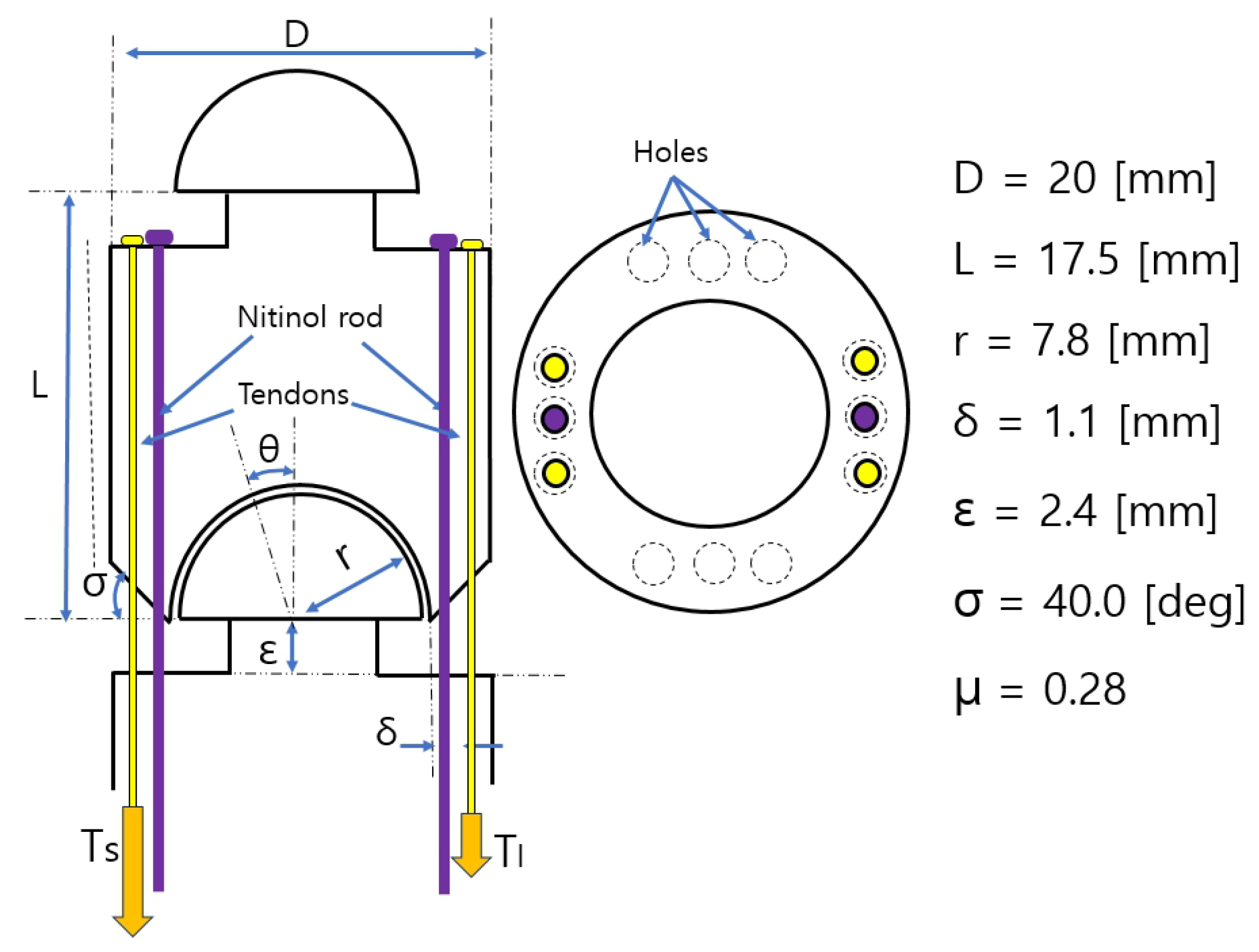
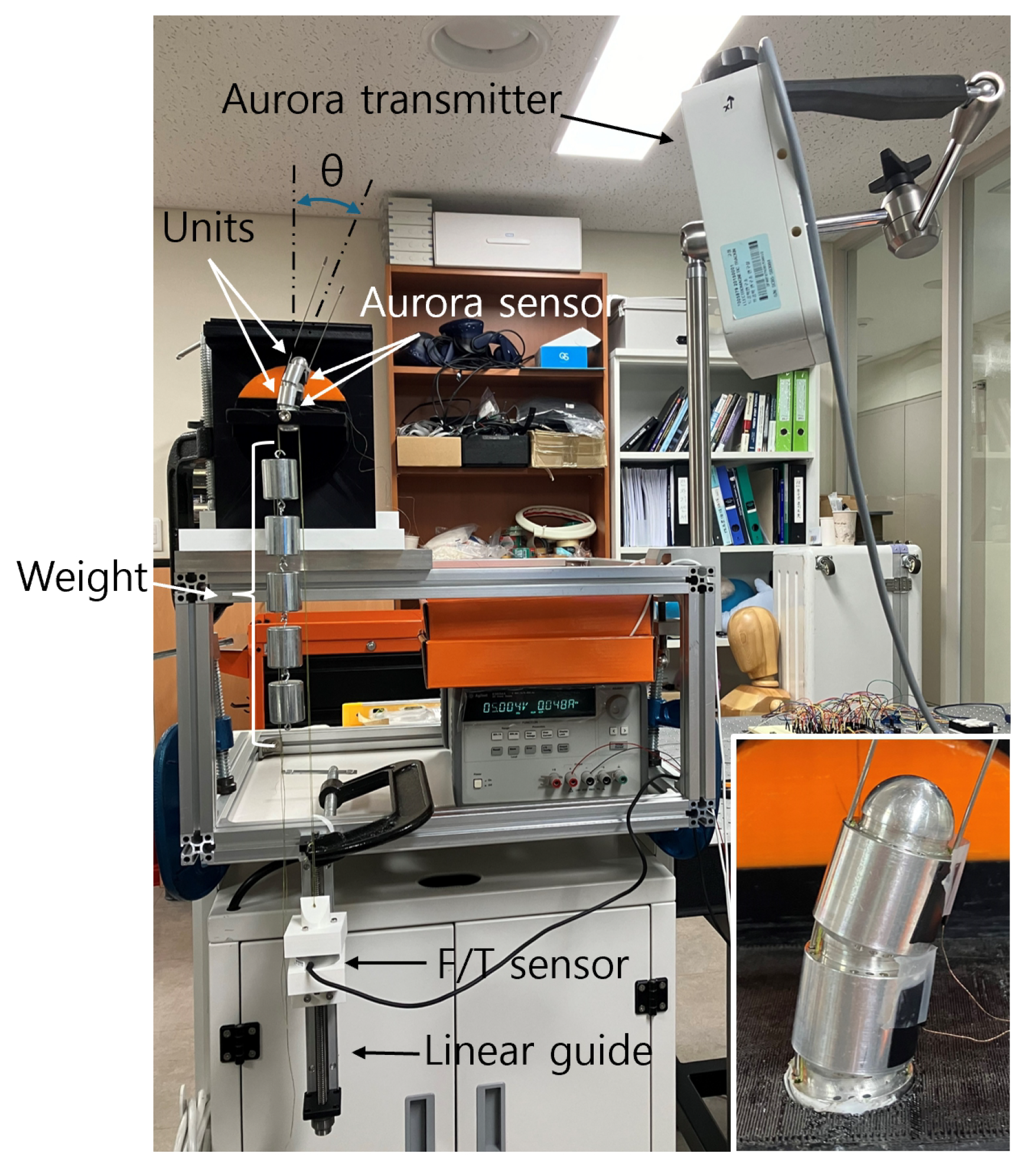

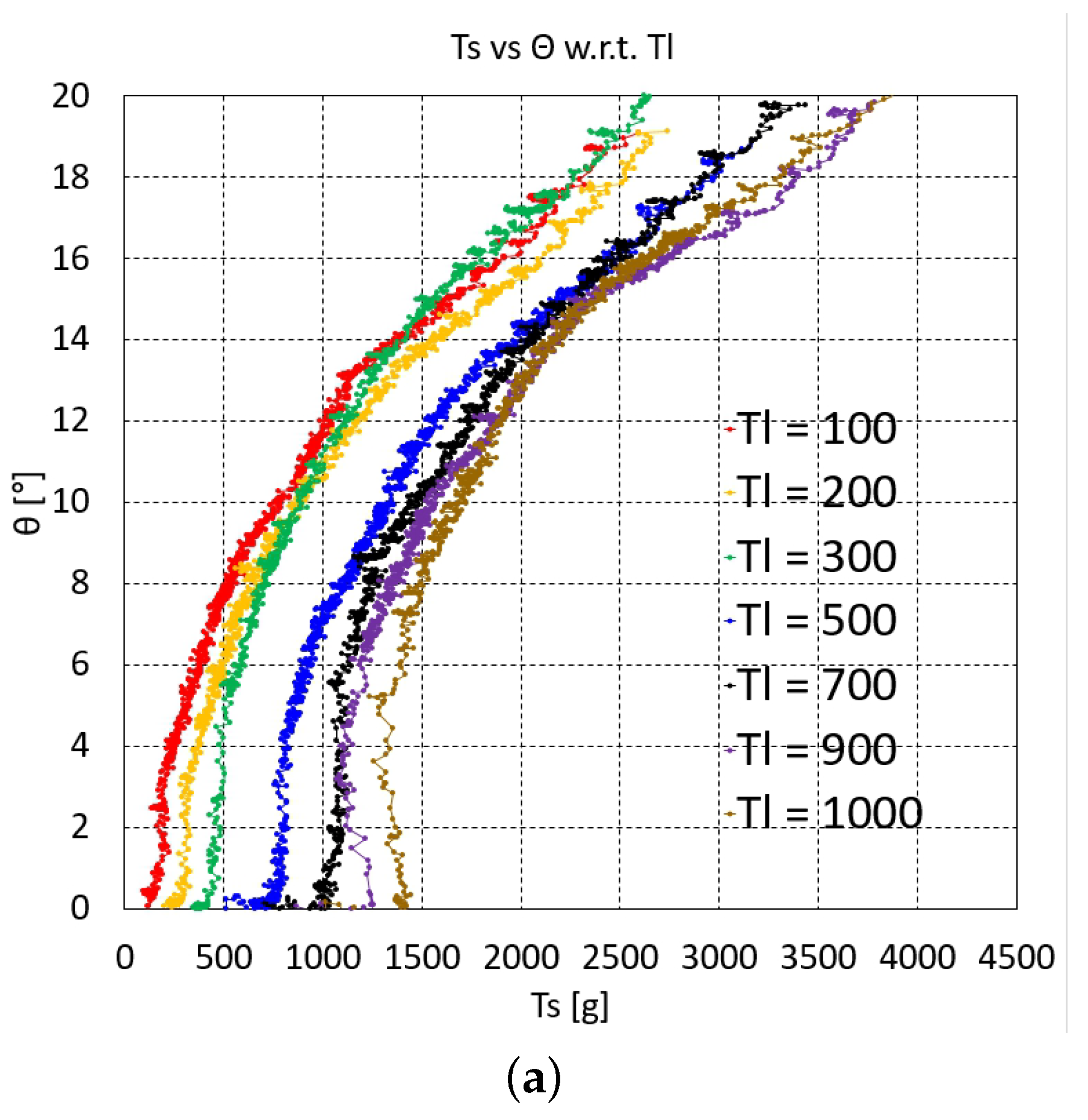
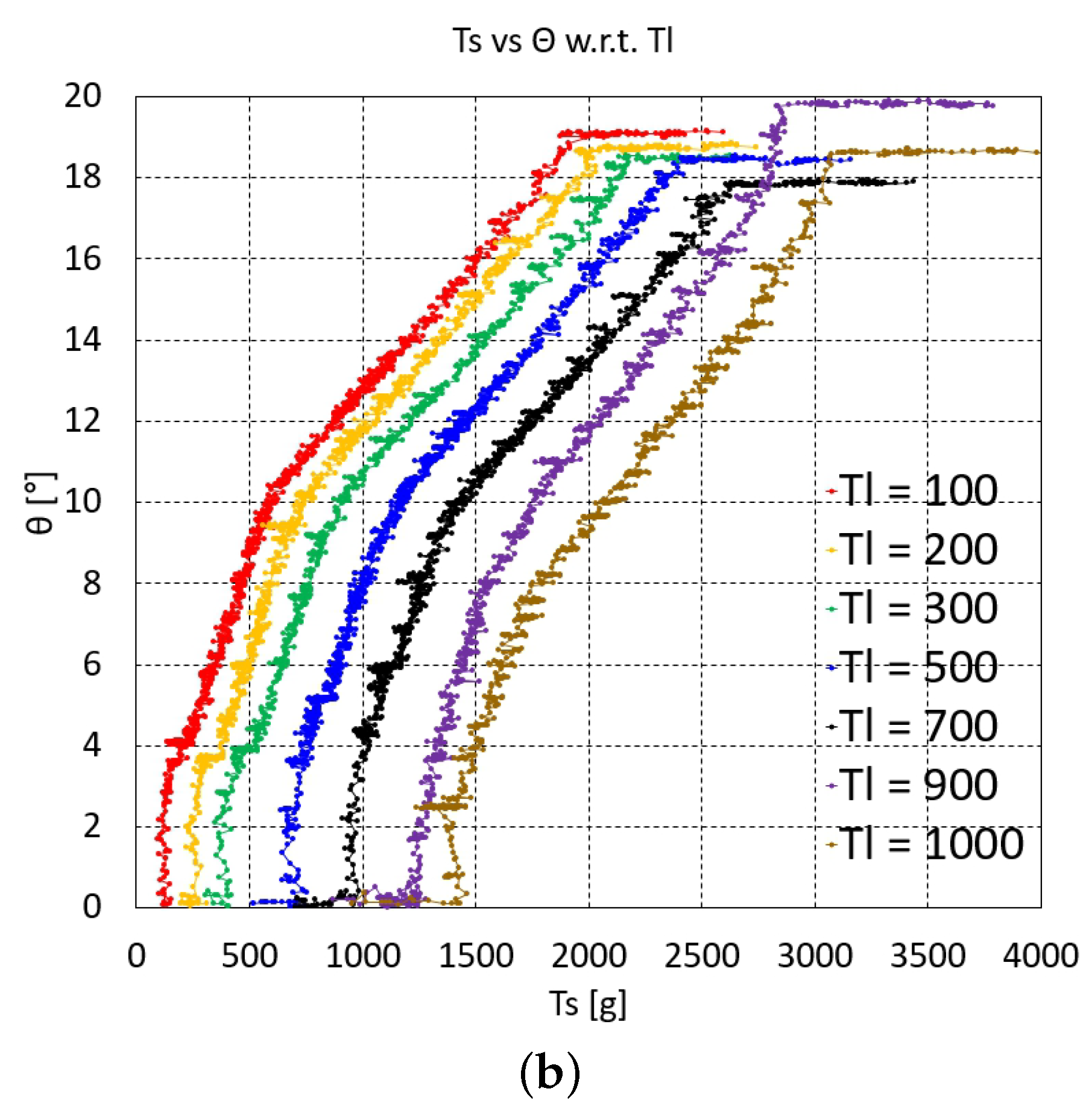


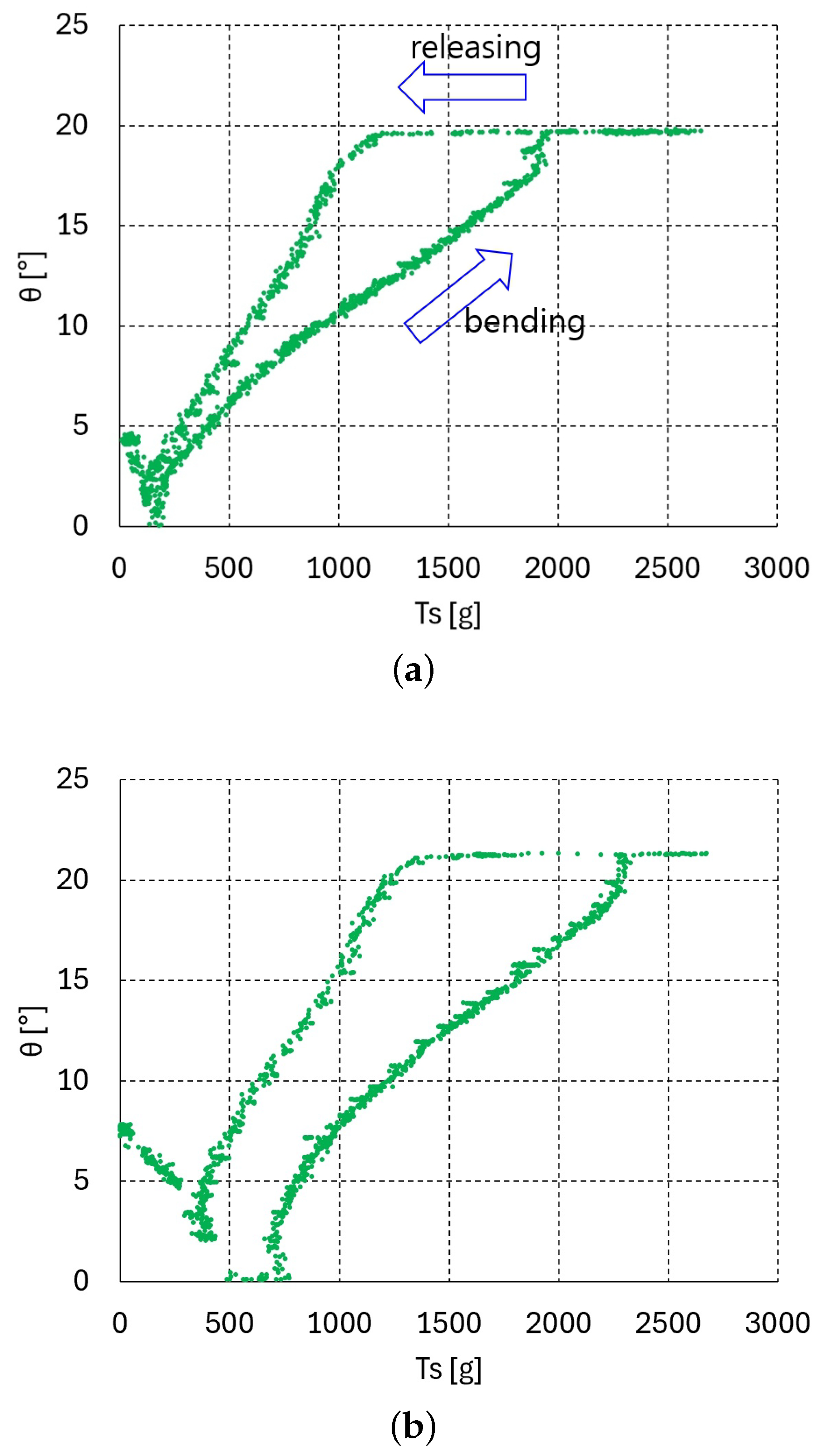
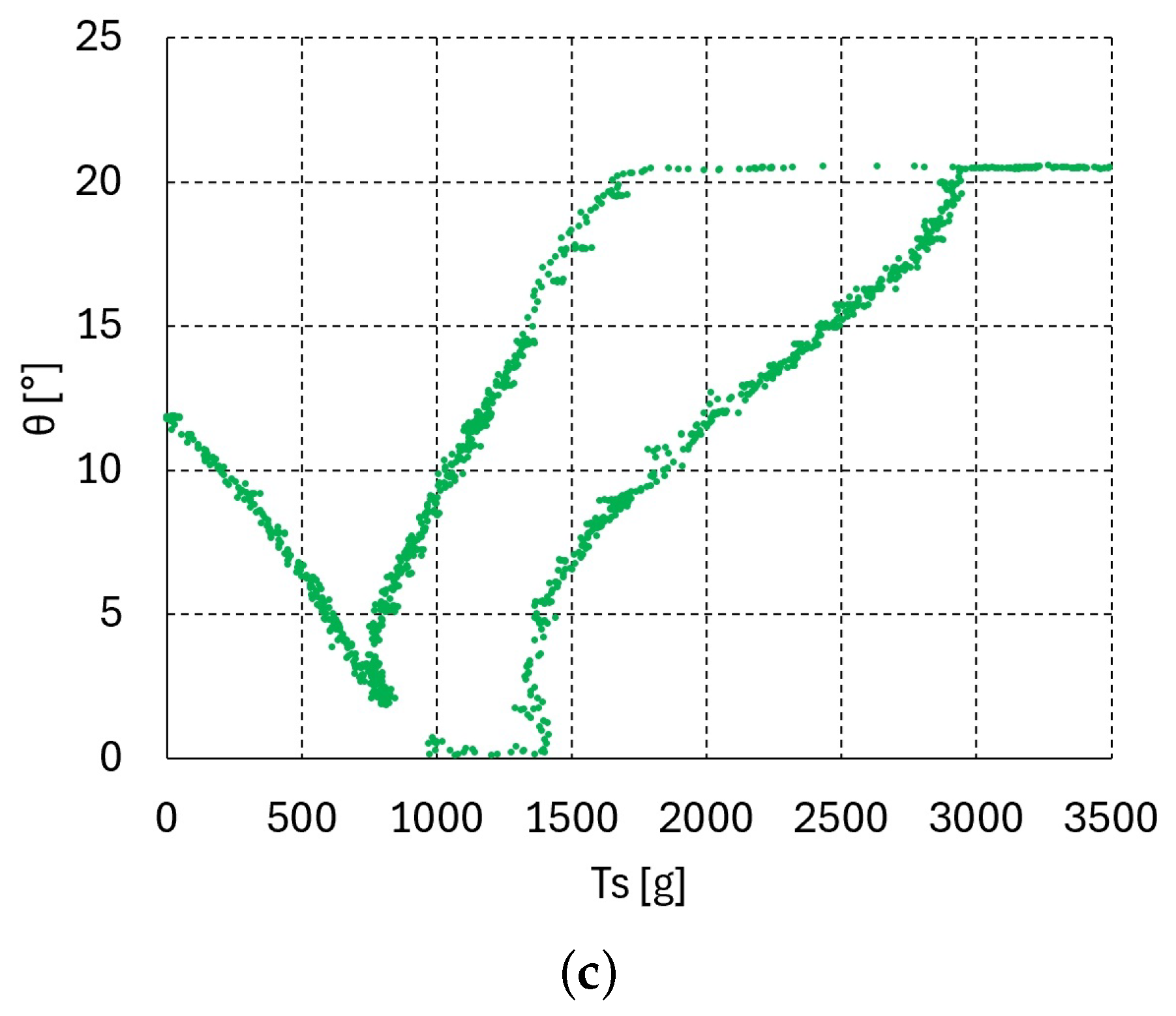


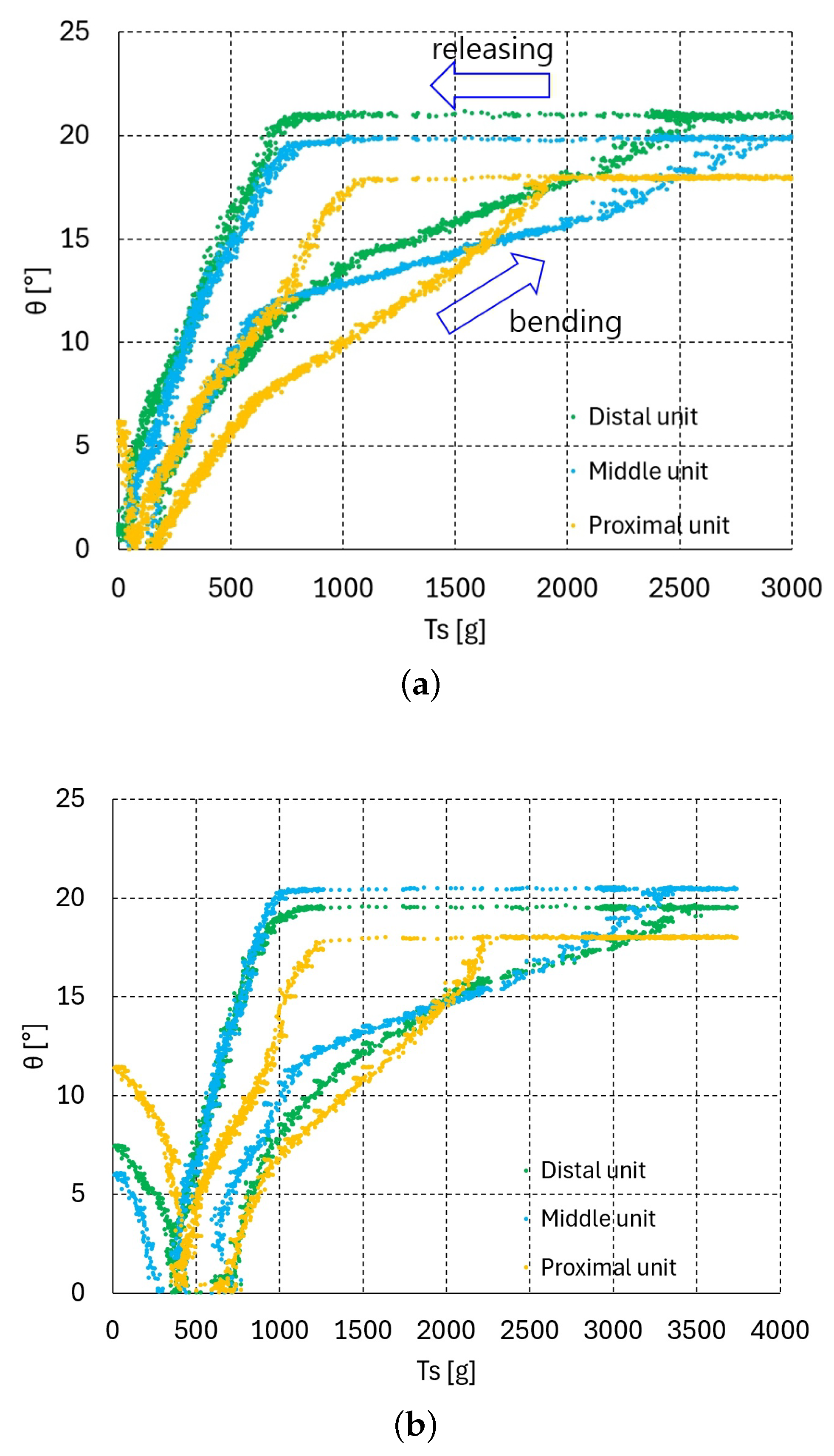


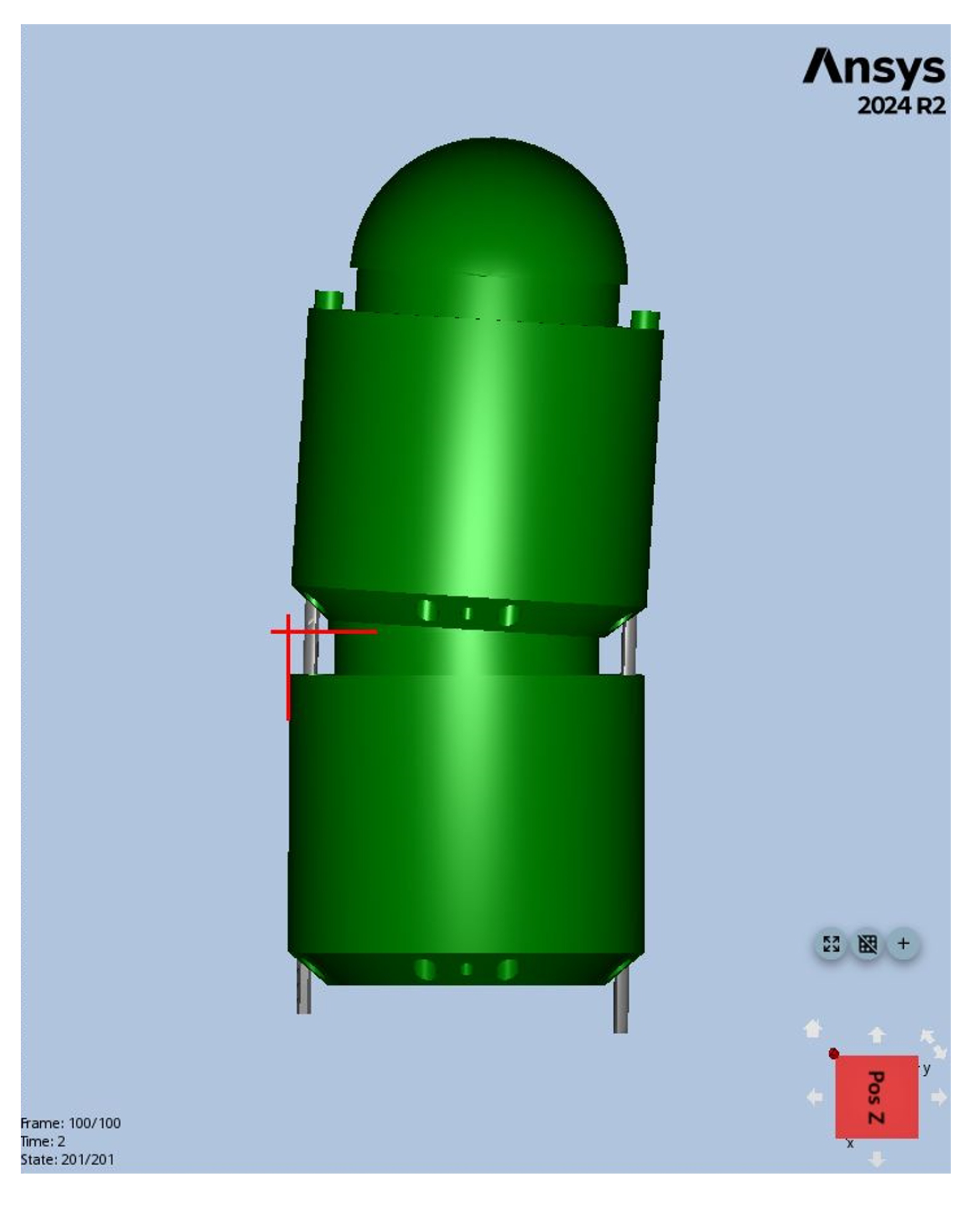


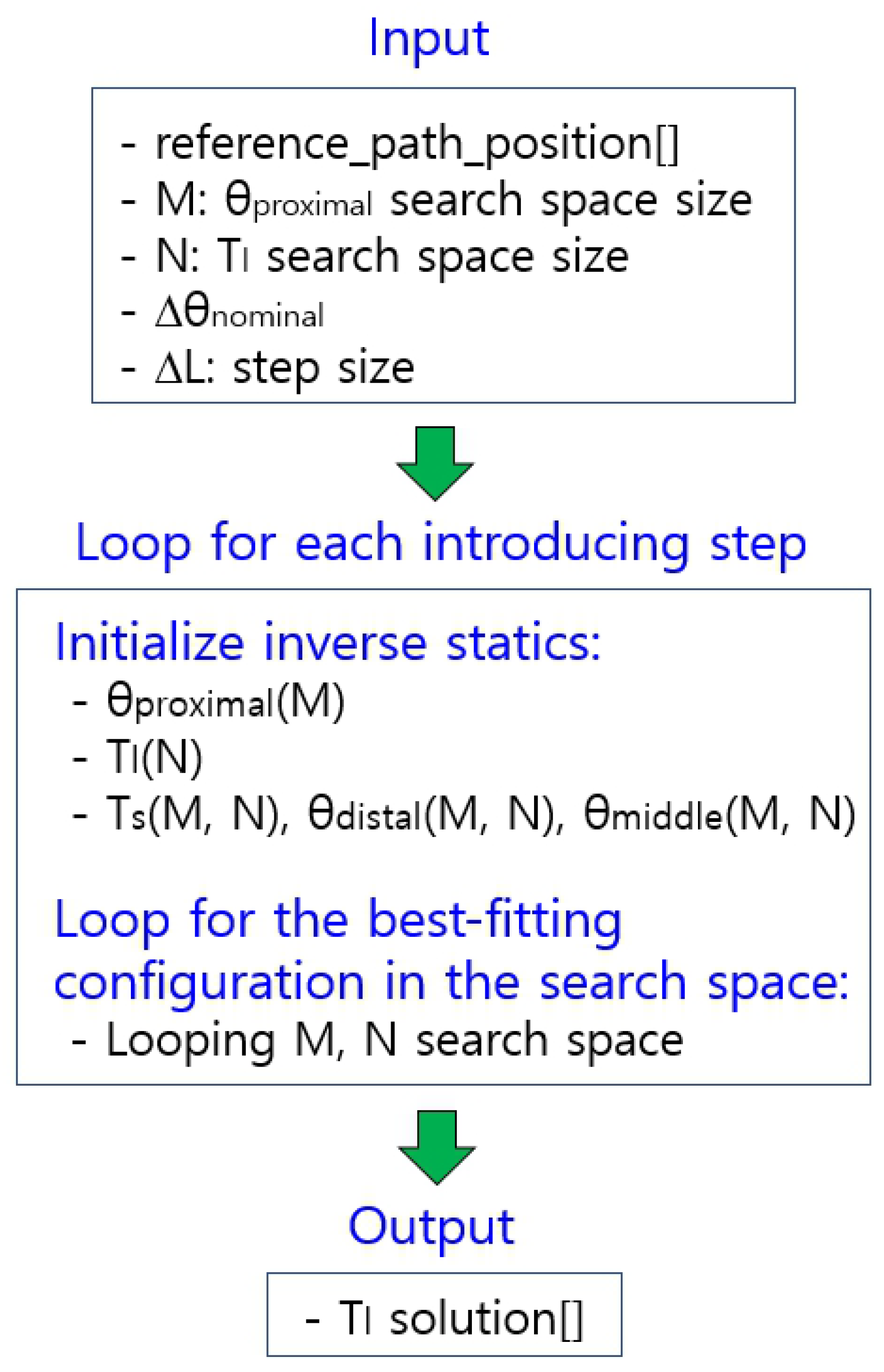
| [g] | Bending Occuring [g] | After Bending [°] |
|---|---|---|
| 100 | – | – |
| 200 | 273 | 2.5 |
| 300 | 405 | 2.5 |
| 500 | 766 | 2.5 |
| 700 | 1038 | 3.0 |
| 900 | 1300 | 3.0 |
| 1000 | 1397 | 5.0 |
| [g] | Bending Occuring [g] | After Bending [°] | ||
|---|---|---|---|---|
| Distal | Proximal | Distal | Proximal | |
| 100 | - | 144 | - | 2 |
| 200 | 277 | 264 | 2.5 | 2.5 |
| 300 | 405 | 406 | 2.5 | 2.5 |
| 500 | 729 | 681 | 2.5 | 2.5 |
| 700 | 1082 | 1036 | 3.5 | 3.5 |
| 900 | 1200 | 1315 | 4 | 4 |
| 1000 | 1450 | 1440 | 4.5 | 4.5 |
| Tl [g] | Bending Occuring [g] | After Bending [°] | ||||
|---|---|---|---|---|---|---|
| Distal | Middle | Proximal | <- | <- | <- | |
| 100 | 178 | - | – | 2.5 | - | – |
| 200 | 274 | 248 | 250 | 3 | 3 | 2 |
| 300 | 500 | 421 | 475 | 2 | 3.5 | 2 |
| 500 | 647 | 640 | 686 | 3 | 3.5 | 3 |
| 700 | 1000 | 950 | 998 | 5 | 5 | 5 |
| 900 | 1250 | 1278 | 1250 | 5 | 5 | 4 |
| 1000 | 1373 | 1466 | 1350 | 5 | 5 | 5 |
| Measured | Abs. Error | % Error | |||
|---|---|---|---|---|---|
| 8 | 150 | 694 | 7.5 | 0.5 | 6.1 |
| 8 | 400 | 882 | 7.8 | 0.2 | 2.6 |
| 8 | 800 | 1414 | 8.0 | 0.0 | 0.1 |
| 12 | 150 | 1173 | 11.3 | 0.7 | 6.1 |
| 12 | 400 | 1325 | 11.9 | 0.1 | 0.7 |
| 12 | 800 | 1867 | 12.3 | 0.3 | 2.6 |
| 16 | 150 | 1661 | 15.6 | 0.4 | 2.8 |
| 16 | 400 | 1801 | 15.7 | 0.3 | 1.9 |
| 16 | 800 | 2353 | 16.2 | 0.1 | 0.9 |
| Avg. | 0.3 | 2.7 | |||
| Std. dev. | 0.2 | 1.9 | |||
| Unit | Measured | Abs. Error | % Error | |||
|---|---|---|---|---|---|---|
| distal | 8 | 150 | 591 | 7.9 | 0.1 | 0.9 |
| 8 | 400 | 896 | 6.7 | 1.3 | 16.1 | |
| 8 | 800 | 1300 | 8.2 | 0.2 | 2.4 | |
| 12 | 150 | 1119 | 11.9 | 0.2 | 1.3 | |
| 12 | 400 | 1353 | 10.4 | 1.6 | 13.3 | |
| 12 | 800 | 1785 | 12.4 | 0.4 | 3.6 | |
| 16 | 150 | 1908 | 15.4 | 0.6 | 3.5 | |
| 16 | 400 | 2088 | 13.5 | 2.5 | 15.6 | |
| 16 | 800 | 2570 | 15.9 | 0.1 | 0.4 | |
| prox imal | 8 | 150 | 528 | 7.3 | 0.7 | 8.3 |
| 8 | 400 | 886 | 6.6 | 1.4 | 17.0 | |
| 8 | 800 | 1468 | 7.5 | 0.5 | 6.6 | |
| 12 | 150 | 960 | 11.5 | 0.5 | 4.2 | |
| 12 | 400 | 1331 | 11.1 | 0.9 | 7.2 | |
| 12 | 800 | 1957 | 10.9 | 1.1 | 8.9 | |
| 16 | 150 | 1546 | 15.5 | 0.5 | 2.9 | |
| 16 | 400 | 1923 | 15.3 | 0.7 | 4.3 | |
| 16 | 800 | 2557 | 15.7 | 0.3 | 2.1 | |
| Avg. | 0.7 | 6.6 | ||||
| Std. dev. | 0.6 | 5.5 | ||||
| Unit | Measured | Abs. Error | % Error | |||
|---|---|---|---|---|---|---|
| distal | 8 | 150 | 477 | 6.8 | 1.2 | 15.3 |
| 8 | 400 | 901 | 8.3 | 0.3 | 3.9 | |
| 8 | 800 | 1365 | 6.5 | 1.5 | 19.0 | |
| 12 | 150 | 887 | 11.1 | 0.9 | 7.7 | |
| 12 | 400 | 1311 | 12.2 | 0.2 | 1.4 | |
| 12 | 800 | 1869 | 11.4 | 0.6 | 5.0 | |
| 16 | 150 | 1536 | 15.3 | 0.7 | 4.4 | |
| 16 | 400 | 2148 | 17.6 | 1.6 | 9.7 | |
| 16 | 800 | 2924 | 17.0 | 1.0 | 6.1 | |
| middle | 8 | 150 | 481 | 7.5 | 0.5 | 5.9 |
| 8 | 400 | 748 | 8.1 | 0.1 | 1.0 | |
| 8 | 800 | 1170 | 7.7 | 0.3 | 3.6 | |
| 12 | 150 | 883 | 11.4 | 0.6 | 4.7 | |
| 12 | 400 | 1051 | 12.2 | 0.2 | 1.8 | |
| 12 | 800 | 1558 | 11.7 | 0.4 | 2.9 | |
| 16 | 150 | 2193 | 15.5 | 0.5 | 2.9 | |
| 16 | 400 | 2304 | 16.1 | 0.1 | 0.8 | |
| 16 | 800 | 2714 | 15.6 | 0.4 | 2.7 | |
| proxi mal | 8 | 150 | 799 | 7.7 | 0.3 | 4.3 |
| 8 | 400 | 982 | 7.5 | 0.5 | 6.5 | |
| 8 | 800 | 1472 | 7.3 | 0.7 | 9.0 | |
| 12 | 150 | 1303 | 11.6 | 0.4 | 3.1 | |
| 12 | 400 | 1458 | 11.3 | 0.7 | 5.6 | |
| 12 | 800 | 1963 | 11.3 | 0.7 | 5.8 | |
| 16 | 150 | 1778 | 15.6 | 0.4 | 2.5 | |
| 16 | 400 | 1963 | 15.6 | 0.4 | 2.8 | |
| 16 | 800 | 2438 | 15.2 | 0.8 | 4.9 | |
| Avg. | 0.6 | 5.3 | ||||
| Std. dev. | 0.4 | 2.1 | ||||
| Step | θdistal [deg] | θmiddle [deg] | θproximal [deg] |
|---|---|---|---|
| 4.00 | 0.00 | 0.00 | 10.03 |
| 5.00 | 0.00 | 0.00 | 17.53 |
| 6.00 | 0.00 | 0.00 | 18.78 |
| 7.00 | 0.00 | 0.00 | 18.78 |
| 8.00 | 16.50 | 0.00 | 15.03 |
| 9.00 | 18.69 | 0.00 | 18.78 |
| 10.00 | 18.69 | 0.00 | 18.78 |
| 11.00 | 18.69 | 0.00 | 18.78 |
| 12.00 | 17.76 | 15.44 | 17.53 |
| Step | [g] | [g] | Avg. position difference [mm] |
| 4.00 | 100.00 | 940.52 | 1.11 |
| 5.00 | 100.00 | 1837.06 | 0.95 |
| 6.00 | 100.00 | 1945.30 | 3.69 |
| 7.00 | 100.00 | 1945.30 | 8.81 |
| 8.00 | 1000.00 | 2768.08 | 2.90 |
| 9.00 | 718.75 | 3101.21 | 2.64 |
| 10.00 | 718.75 | 3101.21 | 10.15 |
| 11.00 | 718.75 | 3101.21 | 19.77 |
| 12.00 | 100.00 | 1920.80 | 6.61 |
Disclaimer/Publisher’s Note: The statements, opinions and data contained in all publications are solely those of the individual author(s) and contributor(s) and not of MDPI and/or the editor(s). MDPI and/or the editor(s) disclaim responsibility for any injury to people or property resulting from any ideas, methods, instructions or products referred to in the content. |
© 2025 by the authors. Licensee MDPI, Basel, Switzerland. This article is an open access article distributed under the terms and conditions of the Creative Commons Attribution (CC BY) license (https://creativecommons.org/licenses/by/4.0/).
Share and Cite
Kim, Y.-J.; Wi, D. Planar Inverse Statics and Path Planning for a Tendon-Driven Discrete Continuum Robot. Robotics 2025, 14, 91. https://doi.org/10.3390/robotics14070091
Kim Y-J, Wi D. Planar Inverse Statics and Path Planning for a Tendon-Driven Discrete Continuum Robot. Robotics. 2025; 14(7):91. https://doi.org/10.3390/robotics14070091
Chicago/Turabian StyleKim, Yeoun-Jae, and Daehan Wi. 2025. "Planar Inverse Statics and Path Planning for a Tendon-Driven Discrete Continuum Robot" Robotics 14, no. 7: 91. https://doi.org/10.3390/robotics14070091
APA StyleKim, Y.-J., & Wi, D. (2025). Planar Inverse Statics and Path Planning for a Tendon-Driven Discrete Continuum Robot. Robotics, 14(7), 91. https://doi.org/10.3390/robotics14070091






